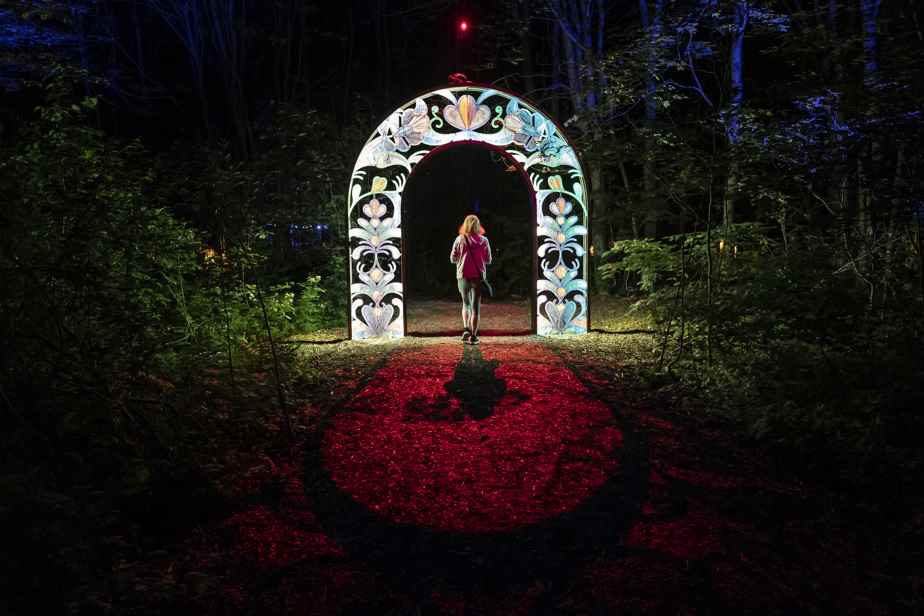A forest of stars. A luminous river which appears on a rock face. The shadow of warriors between the trees. The Onhwa’ Lumina course, a creation of Moment Factory, was recently inaugurated in Wendake, on the outskirts of Quebec. This is the perfect excuse to learn about the Huron-Wendat culture, a very rich and somewhat unknown universe.
Posted at 11:30 a.m.
The best strategy is to first visit the Huron-Wendat Museum, which is part of the First Nations Hotel-Museum of Wendake. You can go there independently, take an audio guide or join a guided tour.

PHOTO EDOUARD PLANTE-FRÉCHETTE, THE PRESS
The First Nations Hotel-Museum seems to be hiding in the heart of the forest.
Whichever method you choose, the visit begins with a great historical overview that allows you to understand where the Huron-Wendat came from (from the Georgian Bay region), what they were originally (mainly farmers sedentary) and what fights they fought (they obtained important judgments from the Supreme Court).
Armed with this information, visitors can explore the material culture of the Huron-Wendat by browsing through the museum’s permanent exhibition. There is a collection of objects, such as bark canoes and sinew snowshoes. We can also see wampums, weavings of shells that had great importance in Aboriginal diplomacy since they could symbolize alliances and treaties.
-

PHOTO EDOUARD PLANTE-FRÉCHETTE, THE PRESS
The Huron-Wendat Museum provides a first glimpse of the culture of this nation.
-

PHOTO EDOUARD PLANTE-FRÉCHETTE, THE PRESS
The site of the longhouse, on the banks of the Akiawenrahk (Saint-Charles) river.
-

PHOTO EDOUARD PLANTE-FRÉCHETTE, THE PRESS
A large wooden palisade protects the longhouse.
-

PHOTO EDOUARD PLANTE-FRÉCHETTE, THE PRESS
A guide talks about life in the longhouse.
1/4
The museum was not satisfied with a simple model of a longhouse to illustrate the traditional Huron-Wendat dwelling, it built one in the gardens of the hotel, behind a high wooden palisade. At the entrance to the vast house, a guide invites visitors to pull a log – an expression that somewhat destabilizes a European family, which is obviously hearing it for the first time. He talks about daily life and in particular about the culture of the three sisters, namely corn, beans and squash, essentials of the Huron-Wendat diet.
-

PHOTO EDOUARD PLANTE-FRÉCHETTE, THE PRESS
The beautiful Tsawenhohi house has hosted many great chefs.
-

PHOTO EDOUARD PLANTE-FRÉCHETTE, THE PRESS
A disturbing sky gives a dramatic aspect to the small Notre-Dame-de-Lorette church.
-

PHOTO EDOUARD PLANTE-FRÉCHETTE, THE PRESS
The Kabir Kouba waterfall is now free, after decades under the yoke of various mills.
1/3
A short walk outside the hotel-museum allows you to visit three other places important to the history and culture of the nation, starting with the Tsawenhohi house. The beautiful residence, completed in 1820, notably housed the great chef Nicolas Vincent Tsawenhohi, a historical figure of the caliber of Donnacona. A few steps away, the small Notre-Dame-de-Lorette church adjoins a historic cemetery where the ancestors of the great Huron-Wendat families, such as the Sioui, the Picard, the Gros-Louis and the Vincent, rest. A little further down, the Akiawenrahk (Saint-Charles) River tumbles at the limit of the Canadian Shield and the St. Lawrence Lowlands to form Kabir Kouba Falls.
At table !
The cultural journey continues at the restaurant of the hotel-museum, La Traite.
The establishment has a brand new chef, Marc de Passorio, who has challenged himself to create a gourmet menu using traditional Huron-Wendat foods, such as the three sisters, and products from hunting, fishing and of picking.
Some classic elements of Huron cuisine remain, such as bannock. It is rumored that it is the recipe of the mother of one of the employees, who came herself on site to give training on the making of this traditional Aboriginal bread.

PHOTO EDOUARD PLANTE-FRÉCHETTE, THE PRESS
A dish of venison medallions at La Traite restaurant at the First Nations Hotel-Musée
On the menu, there is venison, bison, fish and seafood, but also vegetarian dishes. Maple is obviously in the spotlight, especially for dessert.
Moreover, animals, there is no shortage of them in the decor of the hotel. Fox, beaver and raccoon furs adorn the lobby and bedrooms.

PHOTO EDOUARD PLANTE-FRÉCHETTE, THE PRESS
The Hôtel-Musée Premières Nations will soon offer more luxurious rooms following an expansion.
Daring guests can treat themselves to a special package that includes a “myths and legends” evening and an overnight stay in the longhouse.
Sound and light
Visitors can also end the day at Onhwa’ Lumina, a short drive away, for a last look at Huron-Wendat culture.
At the edge of a wood, visitors pass under a luminous arch decorated with traditional embroidery patterns, to embark on a path of just over 1 km which weaves between the trees, lit by wooden lanterns. .
-

PHOTO EDOUARD PLANTE-FRÉCHETTE, THE PRESS
Visitors to Onhwa’ Lumina are invited to a Circle of Life.
-

PHOTO EDOUARD PLANTE-FRÉCHETTE, THE PRESS
The bear is prowling.
-

PHOTO EDOUARD PLANTE-FRÉCHETTE, THE PRESS
Warriors prepare for battle.
-

PHOTO EDOUARD PLANTE-FRÉCHETTE, THE PRESS
Onhwa’, Lumina also pays homage to the ancestors.
1/4
Seven light paintings follow one another, extremely different. One illustrates the creation of the world, with colored projections on stone. Another simulates a longhouse, serene, while wolves and bears prowl around.
Further on, particularly impressive projections on a wooden palisade illustrate the preparation for war. Those who visited the museum earlier in the day recognize a wampum and guess its meaning.
Throughout the course, sound is just as important as lighting. We can hear soft traditional songs or the sounds of the forest: cries, croaks, grunts, howls.
The experience remains very soothing and takes on a particularly poetic touch when crossing a forest of stars. We leave with a new appreciation for the Huron-Wendat culture.

